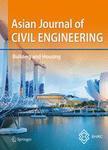版权所有:内蒙古大学图书馆 技术提供:维普资讯• 智图
内蒙古自治区呼和浩特市赛罕区大学西街235号 邮编: 010021

作者机构:Department of Civil Engineering Katihar Engineering College Katihar Bihar Katihar 854109 India Department of Computer Science and Engineering Katihar Engineering College Katihar Bihar Katihar 854109 India
出 版 物:《Asian Journal of Civil Engineering》 (Asian J. Civ. Eng.)
年 卷 期:2024年第25卷第6期
页 面:4471-4486页
主 题:Axial load carrying capacity FOSM PR RF SVR Taylor diagram William’s plot
摘 要:The axial load carrying capacity of rectangular concrete column is acknowledged as one of the key engineering considerations for the construction of such structures. Numerous methods have been used, such as the analytical exact solutions and the finite element approach to compute load carrying capacity of concrete column. Few researchers also used ML technique to predict axial load carrying capacity of column. Therefore, this paper uses three machine learning (ML) models namely support vector regression (SVR), random forest (RF) and polynomial regression (PR) to predict the axial load carrying capacity (Pu) of rectangular concrete columns. These three ML models apply their six key input parameters namely the cross section width (B), cross section depth (D), column length (L), characteristics compressive strength of concrete (fck), characteristics yield strength of steel (fy) and percentage of steel (pt) to 300 datasets in order to predict the axial load carrying capacity (Pu). A range of performance indicators including coefficient of determination (R2), Legates and McCabe index of agreement (LMI), a-10 index, root mean square error (RMSE), mean absolute error (MAE) and expanded uncertainty (U95) are used to assess the efficacy of the well-established machine learning models. The result shows that, of the three proposed machine learning models, PR had the best prediction performance based on performance metrics. This was recognized to its maximum R2 = 1.00 and the lowest RMSE = 5.72E-16 during the training phase, as well as R2 = 1.00 and RMSE = 9.93E-15 during the testing phase. Additional tools for evaluating the model s performance include rank analysis, reliability analysis, regression plot, William s plot, Taylor diagram and error matrix plot. The model s reliability index (β) is calculated using the first-order second moment (FOSM) approach, and the result is comp